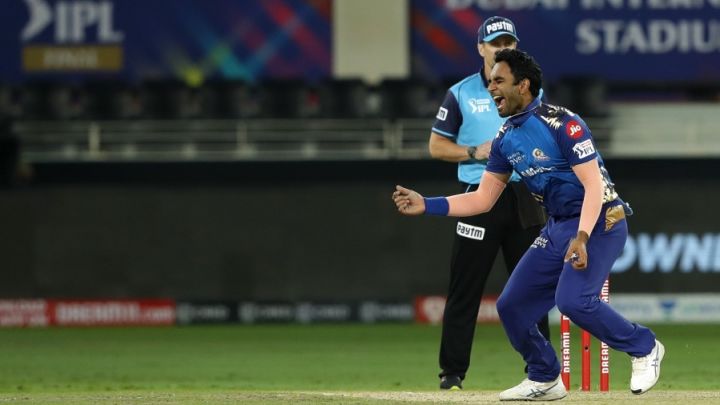Talking Points: Why did Mumbai Indians replace Rahul Chahar with Jayant Yadav?
And did the defending champions miss a trick by not bowling Bumrah when Pant came in?

These are the major talking points from the IPL 2020 final, between the Mumbai Indians and the Delhi Capitals.
Rahul Chahar out, Jayant Yadav in - why?
Rohit Sharma called it a tactical move, replacing Rahul Chahar, their only legspinner, with offspinner Jayant Yadav, who had played just one game this season prior to the final. That game was against the Capitals too, and Yadav did well, returning 3-0-18-0.
What was the tactical bit there, though? With three of the specialist batsmen in the opposition being left-handers - Shikhar Dhawan, Rishabh Pant and Shimron Hetmyer - the Mumbai Indians felt Yadav could be a better option than Chahar, who had a hard time in Qualifier 1, also against the Capitals, leaking 35 runs in two wicketless overs.
This is the second time Yadav has been used by the Mumbai Indians as a tactical pick in the IPL. In Qualifier 1 of IPL 2019, against the Chennai Super Kings, he was brought in with the sole purpose of keeping Suresh Raina quiet, which he did successfully, getting Raina out caught and bowled for just 5.
In many ways, it wasn't a surprise that Yadav played the final. On Monday, Sharma had hinted that Yadav would be a "great option" keeping in mind the Capitals' batting line-up. And the decision was an instant winner as Yadav bowled Dhawan off his third ball. That aside, according to Gautam Gambhir, who is on ESPNcricinfo's expert panel, Yadav made the biggest impact when he bowled two consecutive dot balls to Hetmyer and denied Shreyas Iyer a chance to dominate him. Yadav finished with 4-0-25-1.
Should Jasprit Bumrah have bowled as soon as Rishabh Pant came in?
Jasprit Bumrah had dismissed Rishabh Pant five times in nine innings before today in the IPL. When Pant reached the middle, the Capitals were in a shambles at 22 for 3 in the fourth over, and ESPNcricinfo Forecaster was predicting a final total of 137. Everything pointed to Sharma unleashing Bumrah, who had bowled just one over at that stage, but it didn't happen.
In the end, Pant hit a 38-ball 56, and the Capitals reached 156 for 7. So, did Sharma miss a play there?
During the chat with the official broadcaster in over 14, the Mumbai Indians head coach Mahela Jayawardene conceded that his team was "probably not attacking enough" and had missed out on "challenging" Pant and Shreyas Iyer, who finished on an unbeaten 65 in 50 balls.
By the time Bumrah was brought back for his second over, the Capitals were safer with Pant and Iyer settled - the Capitals were 75 for 3 after ten overs, with Forecaster pegged at 166. Pant, who got his first half-century this IPL, fell (to Nathan Coulter-Nile) with five overs remaining, leaving the Capitals at 118 for 4. Forecaster still said 166. Eventually they stopped ten short of that. Bumrah went wicketless and the Mumbai Indians had perhaps dodged a bullet.
Did Shreyas Iyer slow down at the death?
Social media was abuzz after the Capitals finished at a below-par 156: why did Iyer show such little intent after Pant's dismissal?
Did he actually did slow down, though? And if yes, why? Let's see.
Iyer started well, getting 14 off the first ten balls he had faced. In the first 28 balls he faced, Iyer hit four fours and a six, and scored at a strike rate of 132. However, in the last 22 balls he faced, Iyer just had two fours and a six, with his strike rate coming down to 127. He took nine deliveries to move from 40 to 50.
When Pant got out, the Capitals were 118 for 4 with five overs remaining. Iyer played just 16 of those 30 deliveries, and faced five dot balls. His strike rate in this phase was 144, which in the death overs is average when compared with the likes of, say, Hardik Pandya and Kieron Pollard, who score at nearly 200 in that phase.
What did not help was that Yadav seemed to have the measure of Iyer, giving away just five runs from six deliveries against the Capitals' captain.
In the final two overs, Iyer looked like he was out of gas. Unfortunately for him, Hetmyer and Axar Patel made a combined 14 runs from 14 deliveries. In a similar scenario, the Pandya brothers along with Pollard would likely have scored double that to give the innings a powerful finish.
Iyer could have done better for sure, but it was not entirely his fault.
Should Anrich Nortje have bowled more?
Anrich Nortje has been one of better bowlers in powerplays this IPL, with an economy of 8. Yet, the South African quick was given just the one over in the first six in the final as the Mumbai Indians got to 61 for 1. By the time Nortje returned for his second over, with four overs remaining, only 20 runs were needed for the win.
Nortje did eventually send back Sharma, but it was too late by then. As it turned out, Norjte couldn't even finish his third over as the Mumbai Indians had wrapped up the win by then. It might not have changed the result, but a frontline bowler with a good recent record not bowling out his quota was not the best move on the Capitals' part.
Nagraj Gollapudi is news editor at ESPNcricinfo
Read in App
Elevate your reading experience on ESPNcricinfo App.